He’s a ‘foster parent’ raising baby birds by hand, helping to save threatened species
There is delight in seeing hatchlings poo, and special care in preparing their formula milk. Mark Rusli knows all about the challenges and satisfaction that come with hand-rearing chicks.
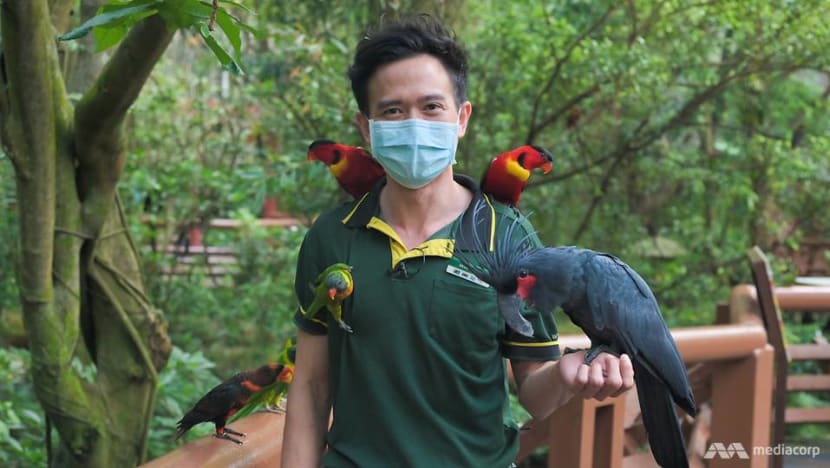
Mark Rusli is one of the Jurong Bird Park's four hand-rearers. (Photo: Wayne Liu)
SINGAPORE: Mark Rusli remembers the time a baby bird died in his care.
Three months into his job as a junior animal care officer in the Jurong Bird Park, he had been hand-feeding a chick and mistook the signs it was displaying.
“He was probably trying to take in a breath of air, instead of wanting to eat. But I gave him papaya — it was a little too wet, so maybe instead of trying to swallow the papaya, he inhaled the water,” recalled the 33-year-old.
“A couple of seconds later, it turned pale and died.”
It was a mistake he vowed never to make again. And in the two years since, he has been able to keep his word.

“When I’m feeding a bird, I know now to take my time, not rush it and just watch the bird carefully,” he said.
Rusli is one of the park’s four hand-rearers, which means it is his job to raise baby birds by hand. It is, he said with a grin, much like being a foster parent to a newborn.
The birds come to him even before they are hatched, as his duties include hatching the eggs besides monitoring their growth until they are old enough to join the larger aviaries.
“They’re helpless and naked, and we need to feed them, sometimes every two hours when they’re really young,” he said.
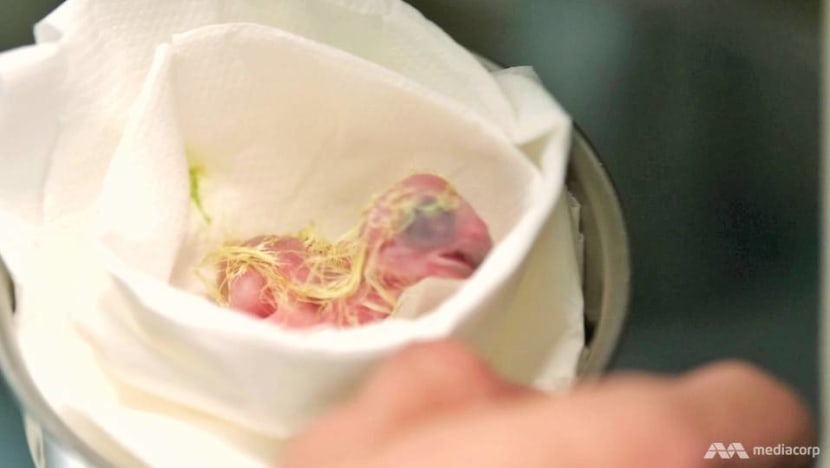
Smaller species like pigeons and passerines, which are perching birds, require a high level of care for six to eight weeks, while the process can take up to eight months or more for larger species like macaws.
Some chicks the team receives are injured or have been abandoned by the parents.
But most of their efforts go into raising birds that have conservation value. In these cases, the team removes the first few batches of eggs laid to incubate them artificially, to increase their chances of survival and, ultimately, raise their numbers.
“Sometimes the parents aren’t very experienced, so they might raise just one chick out of a clutch of three,” he said. “If we were to remove all the three eggs and raise them, they’d all have a higher chance of surviving.”

This makes his role key to the park’s conservation efforts. According to Wildlife Reserves Singapore (WRS), which manages the Jurong Bird Park, Singapore Zoo, Night Safari and River Safari, more than 100 chicks have hatched so far this year.
READ: Jurong Bird Park's conservation breeding efforts soar with more than 100 new hatchlings
One fifth are threatened species. They include a pair of red-fronted macaws — with an estimated wild population of only 200. The park is also one of two zoological institutions in the world breeding the blue-eyed cockatoo.
Beyond conservation, Rusli and his team also function as a support unit for the rest of the park, helping to take the load off other keepers.
“If the other keepers find eggs and chicks, they don’t have to worry about them. They can send them here and worry about their own aviaries,” he said.
WATCH: The "foster daddy" of Jurong Bird Park (6:02)
‘WE GET REALLY EXCITED ABOUT A POO’
Rusli’s day can begin as early as 6am, and it starts with him checking on the birds housed in the park’s breeding and research centre. There are currently about 40 birds, but the number can go up to 60.
His priority is to make sure that they are all alive and well. “A lot can happen overnight because no one’s here for about 12 hours,” he said.
For example, chicks that had been abandoned by their parents could have fallen out of their nests and suffered internal injuries that might not be immediately obvious.
Once he has checked that the birds are fine, the feeding process begins.
First, he prepares the food for the chicks in nurseries, carefully stirring in the right amount of formula — the birds’ version of babies’ milk, he said with a chuckle — and ensuring that the temperature is right so as not to burn them.
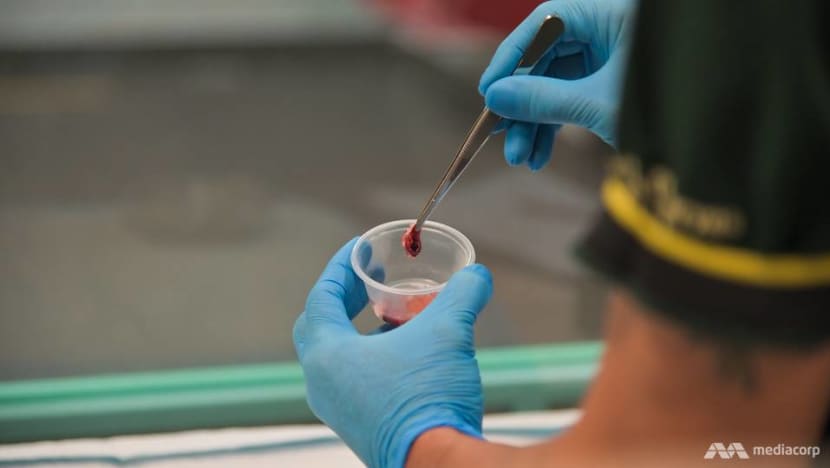
Care is also needed as he feeds the youngest chicks with a syringe, picking them up gingerly and holding them in the palm of his hand.
“When I first started, I was definitely scared of crushing these jelly-bean-like things,” he recalled. “Then I realised they’re not as fragile as a lot of people think they are.”
Still, he must be patient; feed them too much milk, and fluid could go into their lungs.
Once he is done feeding and weighing the youngest chicks, he moves on to the weaning rooms, which are much noisier and where older birds that are fully feathered are kept.
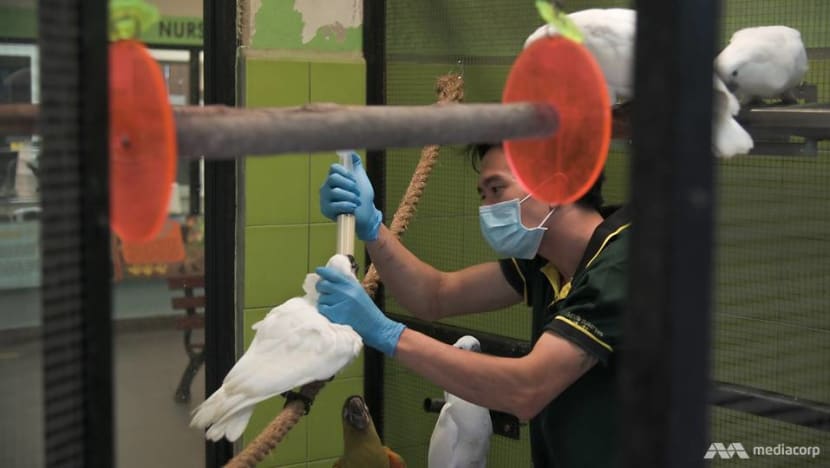
These birds being weaned off formula on to solid food are also given a bigger space to help them develop their muscles.
Besides feeding and charting their growth, Rusli has other tasks that invite comparisons to a parent of a newborn, such as monitoring the poo of particular birds — with the accompanying delight of watching a young one doing it successfully.
“A few of us have mentioned that we get really excited about a poo,” he said, chuckling.
Whichever their shift — 6am to 3.30pm or 8.30am to 6pm — he added that the moments of excitement for the team, when they would be on high alert, are also when a rare chick or egg is in the nursery.
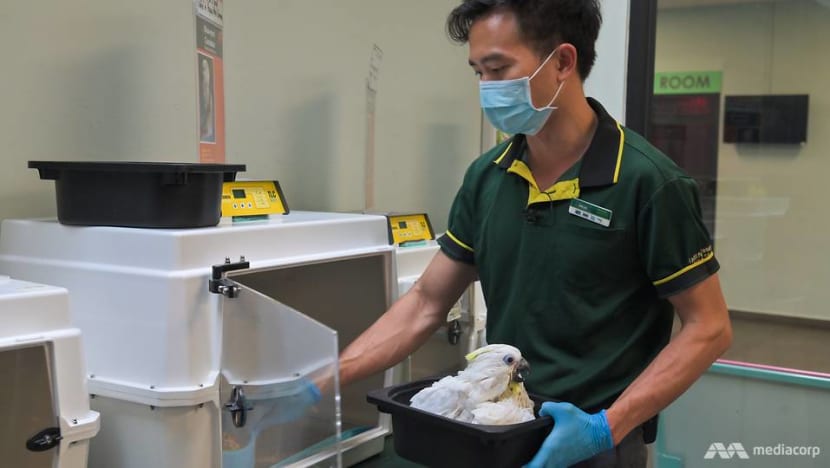
“We’re always texting each other ... on how it’s developing and what to look out for,” he said.
While he has not had a sleepless night over a chick, he knows some of his teammates have. “When I’m at home, I’ll spend some time worrying about the valuable birds,” he said. “But I think I sleep pretty easily!”
NOT INITIALLY WHAT HE HAD IN MIND
Rusli’s day-to-day routine is very different, however, from what it could have been. His first degree was in a completely unrelated field: Sociology. “Halfway through, I realised that I didn’t really want to work in sociology,” he said.
He took up a part-time job in the Night Safari, working mostly with mammals and reptiles, before he graduated and joined WRS full-time for two years until he left to study wildlife science in Australia.
After his studies, he rejoined WRS and assumed that he would be working with animals as before. But events took an unexpected turn when his then boss pitched the idea to him about being a hand-rearer.
“It was very funny because when he threw this (idea) to me, he was kind of cautious about it … like he thought I was going to flat-out reject it,” Rusli recalled. “But I thought it would be an interesting challenge.”
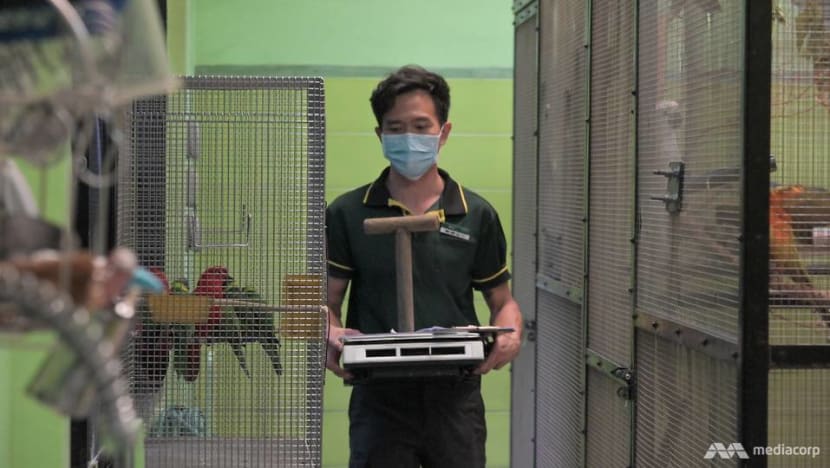
He was not averse to the idea, but he acknowledged that birds were “not an interest” to him at that time.
“There’s a lot more popular interest in things like mammals because they’re cuter and bigger ... Generally, people aren’t as interested in birds because they’re not as charismatic,” he said. “But there are definitely a lot of cool birds out there.”
He did have previous experience with birds while at the Night Safari, where he was once — as he quipped wryly — “that person helping people to take pictures with parrots”.
“They didn’t have enough staff then, but the whole experience helped me bond with the birds and realise that they’re not as boring ... as I thought,” he said.
A BOND BETWEEN MAN AND BIRDS
Working with baby birds, however, initially “rather intimidated” Rusli, who described the posting as “probably one of the most stressful areas in the bird park to work”.
But he also pointed to the satisfaction he feels when he sees a bird he has raised thriving in the aviaries, particularly if it comes from a threatened species.
“We’re breeding a lot of threatened species, and being involved in the process and contributing to conservation efforts is meaningful,” he said.

Satisfaction also comes from the relationships he has built with the various birds that have come through in his care. There is no better way to see this than to follow him in one of the walk-in aviaries.
As he enters, colourful birds of all sizes fly to him, some landing on his head while others peck at his name badge. “I’ve broken a lot of name tags over these guys,” he said with a laugh.
As he greets them, his tone changes, despite previously insisting that he is “not a person who usually makes baby noises”. “Ow! Why’d you do that? Naughty!” he chides one of them.
While he recognises some of them as birds he had hand-reared, others also have a place in his heart — like Jaya the palm cockatoo, which was hand-reared years earlier but was trained as an ambassador bird by a team including Rusli.
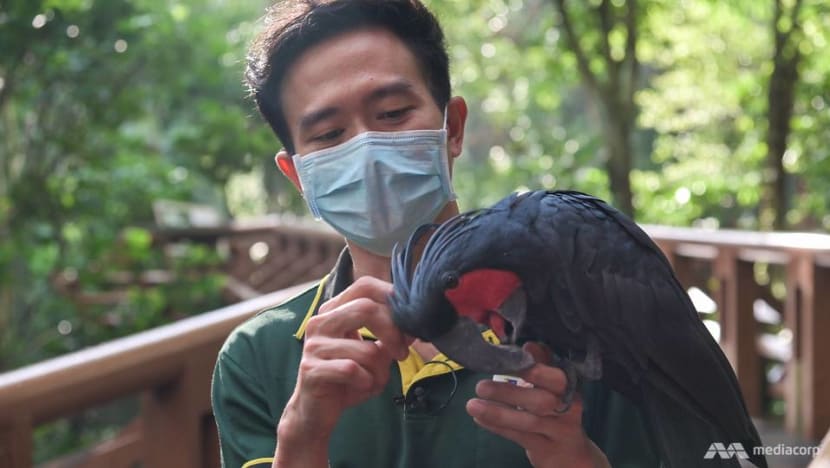
“Look at the size of his beak,” he said as he scratched the top of Jaya’s head affectionately. “He could probably break my fingers if he wanted to.
“The bonding process took a lot of patience, but we got along.”
Over the years, he has grown familiar with the body language and emotions of different birds, and learnt a lot of “cool things, like how parrots can use their feet as an extra pair of hands to break something open”.
“Birds are definitely underrated,” he said. “It’s not just the mammals that people should pay attention to — there are so many interesting things about birds you can learn.”




















